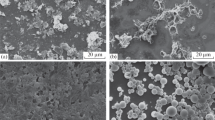Utilizing emulsion polymerization, a microcapsule breaker with a polystyrene-polyacrylamide core-shell structure was synthesized. Ammonium persulfate served as the breaker, polystyrene as the shell, and polyacrylamide as the drug-carrying agent. The results demonstrated that the synthesized microencapsulated gel-breaker exhibited a uniform spherical shape, superior water dispersion, and enhanced thermal stability. Conductivity tests indicated that the core-shell structure of the microcapsules effectively regulated the release of ammonium persulfate as a gel-breaking agent, resulting in delayed polymer gel-breaking.





Similar content being viewed by others
References
Y. Qian, P. Guo, Y. Wang, et al., “Advances in Laboratory-Scale Hydraulic Fracturing Experiments,” Advances in Civil Engineering, 2020, (2020)
M. A. A. Mahesh Chandra Patel, Mazlin Bt Idress, Anirbid Sircar, “Development of a Novel Surfactant-Based Viscoelastic Fluid System as an Alternative Nonpolymeric Fracturing Fluid and Comparative Analysis with Traditional Guar Gum Gel Fluid,” Polymers, 15, 2444(2023)
C. Zhang, Y. Wang, Z. Wang, et al., “Mechanism Analysis of Enhancing the Temperature and Shear Resistance of Hydroxypropyl Guar Gum Fracturing Fluid by Boron-Functionalized Nanosilica Colloidal Crosslinker,” Colloids and Surfaces A: Physicochemical and Engineering Aspects, 676, 132154(2023)
L. W. Guoyan Ma, Chao Hao, Chunbao Du, et al., “Thermal and Rheological Performances Evaluation of a Modified Biopolymer for Fracturing Fluid System,” Molecules (Basel, Switzerland), 27, 7776(2022)
Q. Tang, Z. Huang, B. Wang, H. Lu, “Surfactant-free aqueous foams stabilized with synergy of xanthan-based amphiphilic biopolymer and nanoparticle as potential hydraulic fracturing fluids,” Colloids & Surfaces A: Phys. Eng. Asp, 603, 125215(2020)
M. Ishii, S. Murata, K. Ishitsuka, et al, “Stability of novel cellulose-nanofiber-containing foam as environmentally friendly fracturing fluid,” Journal of Petroleum Science and Engineering, 208, 109512(2022)
O. Budiman, S. Alajmei, “Seawater-Based Fracturing Fluid: A Review,” ACS Omega, 8, 41022-41038(2023)
M. Zhao, S. Liu, Z. Gao, et al., “The spontaneous imbibition mechanisms for enhanced oil recovery by gel breaking fluid of clean fracturing fluid,” Colloids and Surfaces A: Physicochemical and Engineering Aspects, 650, 129568(2022)
M. Zhao, X. Yan, Y. Cheng, et al., “Study on the Imbibition Performance and Mechanism of a Fracturing Fluid and Its Gel Breaking Liquid,” Energy & Fuels, 36, 13028-13036(2022)
J. Cen, X. Huang, A. Liu, J.-C. Yao, “Identification of discontinuous parameters in contaminant convection–reaction– diffusion model of recovered fracturing fluid,” Communications in Nonlinear Science and Numerical Simulation, 128, 107634(2024)
X. Dong, W. Li, Q. Liu, et al., “Research on the Convection-Reaction-Diffusion Model of Contaminants in Fracturing Flowback Fluid in Non-Equidistant Artificial Fractures with Arbitrary Inclination in (3+1)-Dimensional Space-Time,” ACS Omega, 8, 17901-17921(2023)
T. Bollhorst, K. Rezwan, M. Maas, “Colloidal capsules: nano- and microcapsules with colloidal particle shells,” Chemical Society Reviews, 46, 2091-2126(2017)
E. Koh and Y. T. Lee, “Preparation of Ligand Brush Nanocapsules for Robust Self-Controlled Antimicrobial Activity with Low Cytotoxicity at Target pH and Humidity,” Pharmaceutics, 14, 280(2022)
S. T. Pham, K. A. Tieu, S. Wan, et al, “Intrinsic Effect of Nanoparticles on the Mechanical Rupture of Doubled-Shell Colloidal Capsule via In Situ TEM Mechanical Testing and STEM Interfacial Analysis,” Small (Weinheim an der Bergstrasse, Germany), 16, e2001978(2020)
Y. Sun, J. Shi, Z. Cai, et al, “Mussel-inspired capsules toward reaction-triggered cargo release,” Materials Chemistry Frontiers, 5, 792-798(2021)
Lieqiang Liao, Xinjian Jia, H. Lou, et al. “Supramolecular gel formation regulated by water content in organic solvents: self-assembly mechanism and biomedical applications,” RSC Advances, 11, 11519-11528(2021).
Author information
Authors and Affiliations
Corresponding author
Additional information
Translated from Khimiya i Tekhnologiya Topliv i Masel, No. 2, pp. 79–82, March– April, 2024.
Rights and permissions
Springer Nature or its licensor (e.g. a society or other partner) holds exclusive rights to this article under a publishing agreement with the author(s) or other rightsholder(s); author self-archiving of the accepted manuscript version of this article is solely governed by the terms of such publishing agreement and applicable law.
About this article
Cite this article
Liu, T., Ye, Z. & Liu, D. Preparation and Performance Evaluation of P(St-AM) Microencapsulated Gel-Breaking Agents with Core-Shell Structure. Chem Technol Fuels Oils 60, 309–314 (2024). https://doi.org/10.1007/s10553-024-01685-y
Published:
Issue Date:
DOI: https://doi.org/10.1007/s10553-024-01685-y




